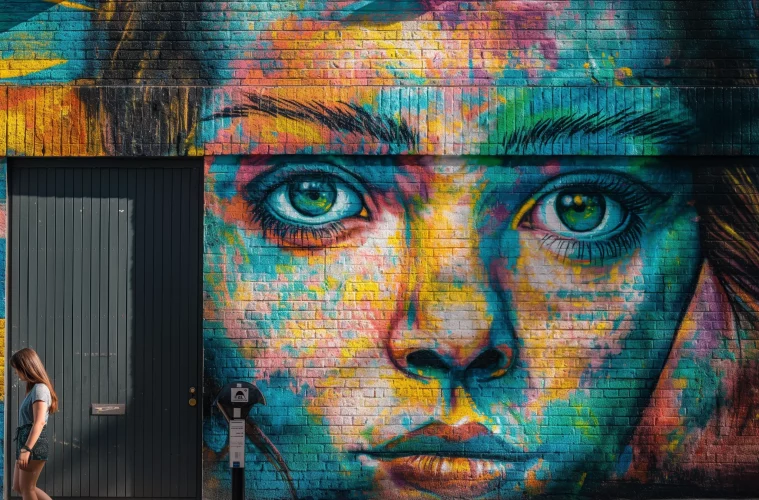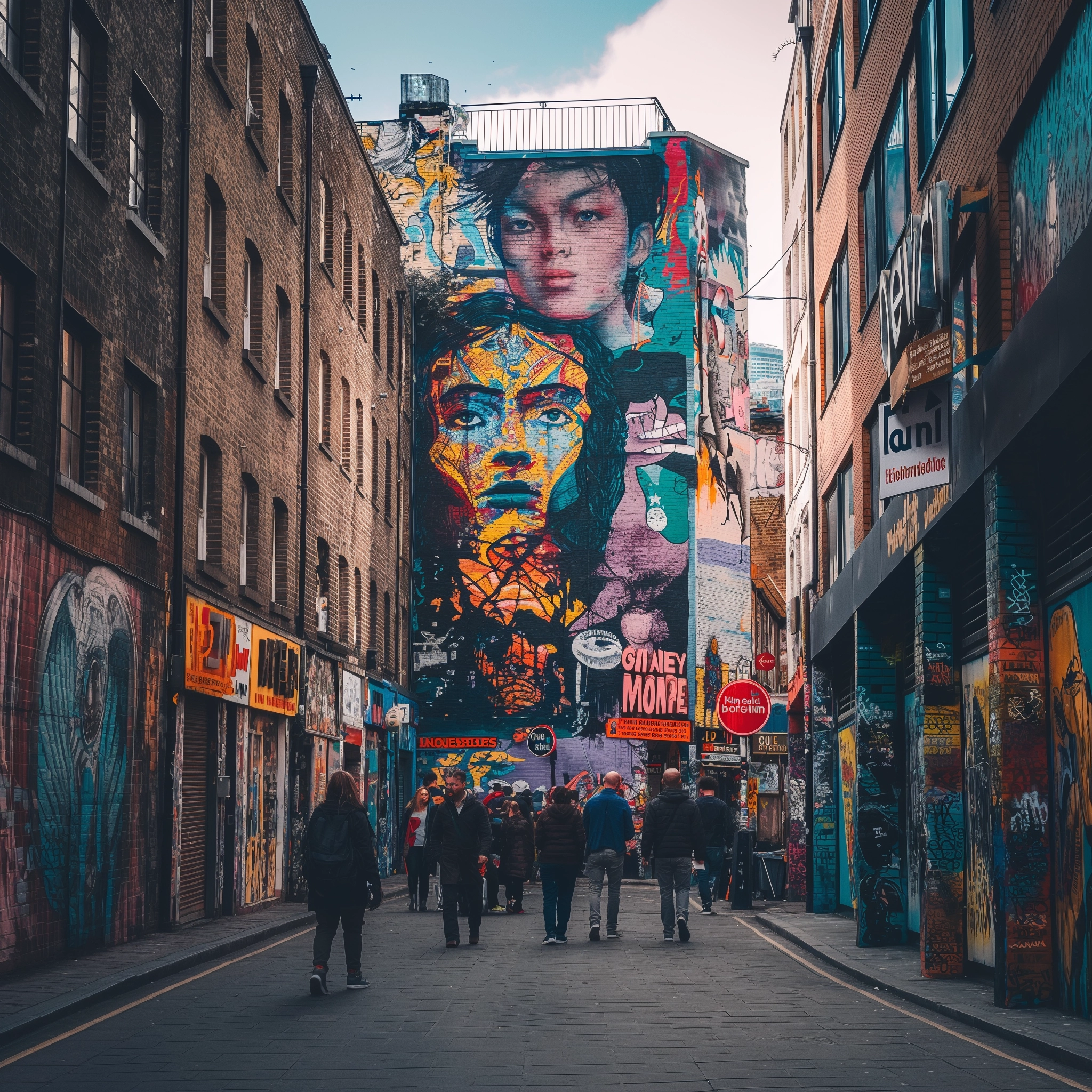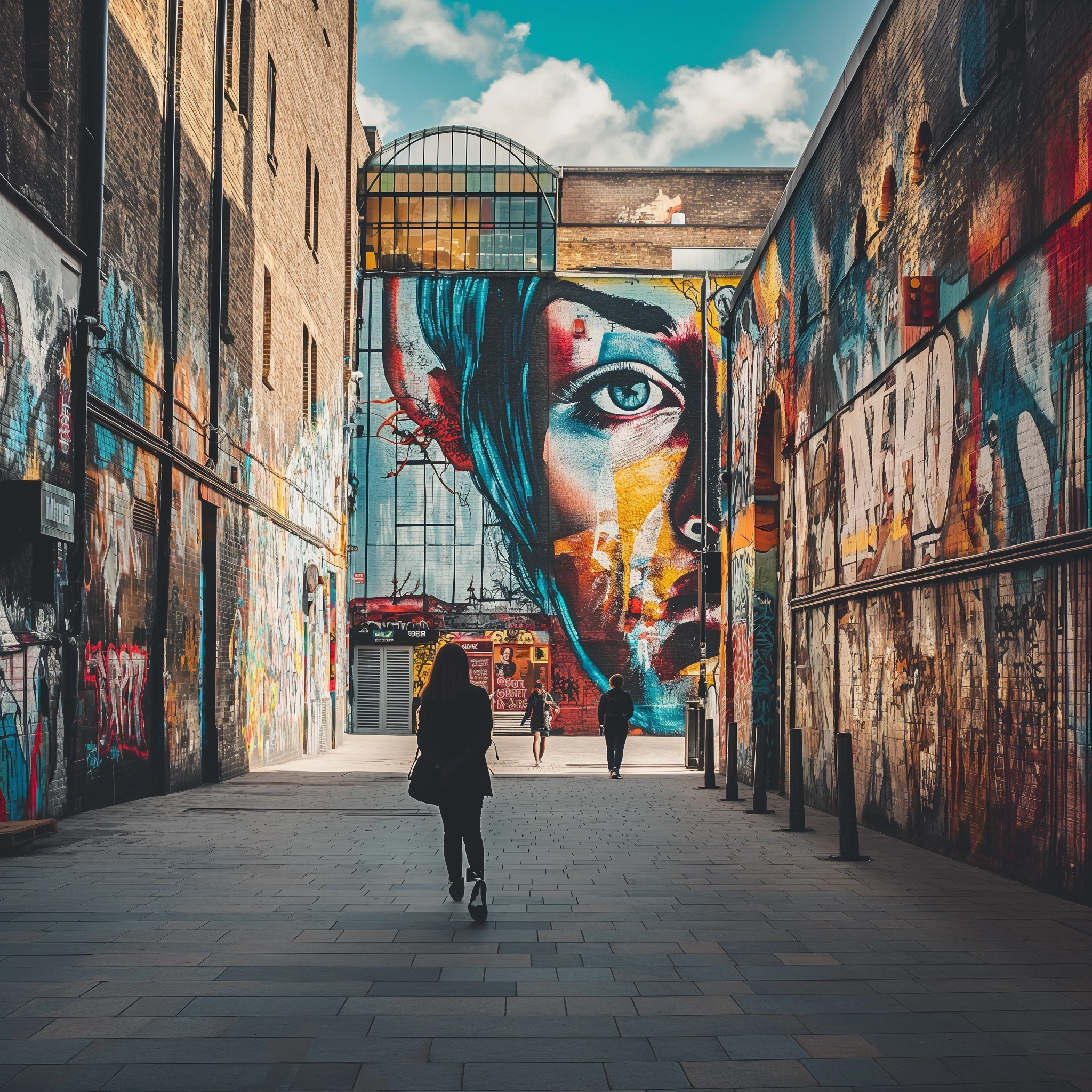Introduction: Why Explore London’s Public Art and Street Art?
London’s streets are a vibrant tableau, rich with public and street art that transforms the city into a dynamic gallery open to all. This eclectic mix of art forms makes London a unique hub for artistic expression, drawing artists and enthusiasts from around the globe.
What Makes London a Hub for Public and Street Art?
The city’s history and cultural diversity are mirrored in its art, with pieces ranging from classic sculptures to contemporary street murals. London’s global stage allows artists to showcase their work, making the city a living canvas that reflects a spectrum of stories and styles.
Enhancing Your London Experience Through Art
Exploring London’s art scene offers more than visual delight; it provides a deeper understanding of the city’s identity and cultural evolution. Art tours present a unique perspective, unveiling the narratives behind each piece and the areas they adorn.
The Unique Perspective of Art Tours
Art tours in London peel back layers of the city’s bustling life, revealing the creativity embedded in its fabric. These tours enrich the experience of both locals and visitors, offering new insights with every exploration.
An Exciting Time for Art Discovery
Now is an exciting time to immerse yourself in London’s art scene. The landscape is ever-changing, with new artworks continually emerging, inviting onlookers to experience the city’s vibrancy and diversity through the lens of art.
The Evolution of Street Art in London
Street art in London has undergone a remarkable transformation, evolving from an act often viewed as vandalism to becoming a celebrated form of cultural expression. This journey reflects not just a change in perception but the city’s dynamic spirit.
From Vandalism to Valued Culture
Once seen as a blight on London’s urban landscape, street art has been reimagined. Artists like Banksy have played pivotal roles in this shift, using the city’s walls to comment on society, politics, and human emotions. This renaissance has elevated street art, inviting viewers to reflect and engage in a dialogue.
Community and Artist Collaboration
The transformation of street art in London owes much to the collaboration between artists and the communities they paint in. Murals and installations have become sources of pride, turning once-overlooked areas into tourist attractions and hubs of creativity.
London vs. The World
Comparing London’s street art scene with global counterparts, it’s clear that the city holds its own. Its unique blend of history, multiculturalism, and artistic freedom has fostered a diverse and vibrant street art scene unparalleled in its scope and significance.
Impact on Neighborhoods and Cultural Identity
Street art has significantly impacted London’s neighbourhoods, instilling a sense of identity and community. It has turned ordinary streets into galleries, making art accessible to all and reflecting the city’s evolving cultural narrative. Through its colours and forms, London’s street art continues to shape its cultural identity, telling stories that resonate with both locals and visitors alike.
Iconic Public Artworks and Their Stories
London’s landscape is dotted with public artworks that not only beautify the city but also tell tales of its rich history and diversity. These iconic pieces, from statues to modern installations, spark conversations and sometimes controversies, reflecting the city’s dynamic cultural landscape.
Stories Behind the Art
Among the most iconic artworks is the Fourth Plinth in Trafalgar Square, a site for rotating contemporary art installations that challenge and engage the public. Each piece selected for display here tells a different story, from political commentary to social observation, showcasing the city’s openness to diverse narratives.
Reflecting London’s History and Diversity
Public artworks like the monumental “Nelson’s Column” or the more recent “Illuminated River” project on the Thames bridges serve as markers of London’s history and its future aspirations. They celebrate the city’s achievements, memorialise its challenges, and embrace its multicultural identity, adding layers of meaning to the urban environment.
Controversies and Conversations
Not all public art is met with universal acclaim. Controversies often arise over themes, interpretations, or even the art’s existence itself, such as the debate around the “Banksy versus The Royal Academy” incident. These discussions are vital, as they underscore the role of public art in fostering civic dialogue.
Contribution to the Visual and Cultural Landscape
These artworks contribute significantly to London’s visual and cultural landscape, making art accessible to all and turning the city itself into an open-air gallery. They enhance the urban experience, inviting residents and visitors alike to reflect, appreciate, and engage with the world around them through the lens of art.
Navigating London’s Street Art Districts
London’s vibrant street art scene is scattered across several districts, each with its unique flair and contributions to the city’s reputation as a street art haven. As you wander through these areas, you’ll discover more than just art; you’ll uncover the heart and soul of London’s diverse communities.
Key Districts and Their Unique Traits
Shoreditch, in East London, stands out for its eclectic mix of graffiti, murals, and installations, making it a must-visit for any street art enthusiast. Camden is known for its punk rock roots and vibrant murals that reflect the area’s musical heritage. Meanwhile, Southbank showcases a more institutional form of street art, with legal graffiti walls and skateboarding culture.
Discovering Hidden Gems
The best way to explore these areas is on foot, with an open mind and keen eyes. Guided tours can offer valuable insights into the artists and their works, but don’t shy away from venturing down side streets and alleys where many hidden gems await.
Overcoming Challenges
Navigating through London’s street art districts may sometimes feel overwhelming due to the sheer volume of art. Staying flexible with your plans and using social media or apps dedicated to street art can help you pinpoint must-see pieces.
Contribution to London’s Street Art Reputation
These districts, with their unique contributions and vibrant artworks, reinforce London’s status as a global street art capital. They not only attract artists from all over the world but also foster a sense of community and creativity that is palpable to anyone who visits.
The Art of Discovery: Self-Guided Tours vs. Organised Art Walks
Choosing between a self-guided tour and an organised art walk in London’s street art scene can shape your experience in unique ways. Both methods offer distinct advantages and contribute to the art community differently.
Advantages of Organised Street Art Tours
Organised tours provide a curated experience, offering deep insights into the artists’ backgrounds, the history of the pieces, and the cultural context of the neighbourhoods. Led by knowledgeable guides, these tours ensure you don’t miss out on hidden gems and understand the significance behind each artwork.
Crafting Your Own Street Art Discovery Route
For those who crave adventure, creating a self-guided tour allows for flexibility and personal discovery. You’re free to explore at your own pace, choosing which artworks to delve into more deeply. This approach encourages spontaneous exploration, often leading to unexpected and rewarding finds.
Digital Tools for Enhanced Exploration
Various apps and online maps are available to enhance your street art exploration, providing locations, artist information, and even augmented reality views of certain artworks. These tools make it easier to navigate and uncover the stories behind the street art.
Diverse Contributions to the Art Community
While organised tours support local artists and guides financially and help educate the public about the street art scene, self-guided tours encourage individual exploration and personal interpretation, fostering a deeper personal connection with the art. Both methods play vital roles in engaging with and supporting London’s vibrant street art community.
The Role of Art in Community and Urban Regeneration
Public and street art have become powerful tools for community building and urban regeneration in London, turning neglected spaces into vibrant hubs of creativity and interaction.
Transforming Spaces into Communities
Art initiatives have revitalised areas by creating engaging public spaces that foster a sense of belonging and identity. Murals and installations often become focal points for community interaction, encouraging residents and visitors to connect with the area and each other.
Success Stories of Art-Led Regeneration
One notable example is the transformation of Shoreditch, where street art has played a pivotal role in the area’s redevelopment. Once industrial and overlooked, it’s now a thriving cultural district. Similarly, the Brixton Windmill mural project has brought together artists and residents, revitalising the area while preserving its heritage.
Collaborative Efforts in Public Art Projects
Collaboration is key in these projects, with artists, local authorities, and communities working together to ensure that public art reflects local history, values, and aspirations. This collaborative process ensures that the art serves as a genuine representation of the community’s identity.
Overcoming Challenges
Regeneration projects face challenges, such as funding constraints and differing opinions on art’s role in public spaces. These are addressed through open dialogue, inclusive planning processes, and innovative funding solutions, ensuring that regeneration efforts are sustainable and beneficial to all stakeholders.
Interactive and Digital Art Experiences in London
London’s art scene is not just about static paintings and sculptures; it’s also home to cutting-edge interactive and digital art experiences that blend technology with traditional art forms. These innovative experiences invite you to engage with art in ways that are immersive and dynamic.
Blending Technology with Art
Notable experiences include the immersive installations at the Tate Modern, where digital projections transform spaces into living artworks. Another example is the interactive light installations along the Thames, which react to the movement of water and passersby, creating a constantly evolving visual spectacle.
Engaging Wider Audiences
Interactive and digital artworks play a crucial role in making art accessible and engaging to wider audiences. They break down the barriers of traditional art viewing, allowing for a more personal and immersive experience. This inclusivity invites those who might not usually engage with art to explore and interact with creative works.
Discovering Interactive Art in London
Visitors can find these experiences by checking the schedules of major art galleries, such as the Tate Modern, the Design Museum, and smaller galleries that specialise in digital art. Many installations are also public, located in parks or along the river, making them easy to stumble upon and enjoy.
Interactive and digital art experiences in London offer a unique way to connect with art, blending the lines between the viewer and the artwork and creating memorable experiences that resonate long after the visit.
Supporting Local Artists and Art Scenes
Supporting local artists and the art scene in London is vital for the sustainability and vibrancy of the city’s cultural landscape. Whether you’re a Londoner or visiting, there are numerous ways to engage with and support the local art community.
Ways to Support Local Art
You can support local artists by attending exhibitions, purchasing artwork, or even sharing their work on social media. Visiting local galleries and art fairs is not only a great way to discover new artists but also contributes directly to the artists’ livelihoods.
Initiatives Promoting Emerging Artists
London is home to various initiatives and programs designed to promote emerging artists. For instance, the Mayor’s “Culture Seeds” program funds community-led cultural projects, including those in the visual arts. Art schools and local councils often host exhibitions showcasing up-and-coming talent, providing them with the exposure needed to kickstart their careers.
Contribution of Sales and Exhibitions
Art sales and exhibitions play a crucial role in the art community’s sustainability, providing artists with the financial means to continue their work. Additionally, these events foster a sense of community and offer networking opportunities for artists and art lovers alike.
Addressing Challenges Faced by Artists
Local artists face numerous challenges, from finding affordable studio space to gaining exposure. The public can help by advocating for policies that support the arts, participating in crowdfunding campaigns for art projects, and simply by showing up and engaging with the art scene.
By actively supporting local artists and art scenes, we contribute to the cultural richness of London, ensuring it remains a vibrant, creative city for generations to come.
Art Festivals and Events: Celebrating Creativity in the Capital
London’s calendar is dotted with art festivals and events that celebrate the city’s creativity and cultural diversity. These gatherings are not just opportunities to view art but are vibrant spaces for interaction, learning, and discovery.
Key Festivals and Events
The London Design Festival and Frieze London are standout events, offering a mix of contemporary art, design installations, and interactive experiences. The Notting Hill Carnival, though not strictly an art festival, is a spectacular showcase of London’s multicultural heritage through costumes, music, and dance.
Showcasing Diversity and Talent
These events highlight the diversity and talent within London’s art scene, featuring works from internationally renowned artists to emerging local talents. They serve as platforms for artists to gain exposure and for audiences to experience the breadth of creativity the city has to offer.
Opportunities for Artists and Enthusiasts
For artists, these festivals are a chance to network, gain inspiration, and sell their work. Art enthusiasts, on the other hand, can participate in workshops, talks, and guided tours, deepening their understanding of art.
Maximising the Festival Experience
To make the most out of these festivals, visitors should plan ahead, checking schedules for special events and exhibitions. Engaging with artists, participating in interactive installations, and joining community art projects can enrich the festival experience, offering insights into London’s dynamic art world
Final Thoughts: The Endless Discovery of London’s Art
Exploring London’s public and street art is truly an endless journey, one that offers new experiences, insights, and inspirations with every visit. This dynamic city’s art scene is constantly evolving, ensuring that no two trips to its districts are ever the same.
An Ongoing Journey of Discovery
The ever-changing nature of street art, with new pieces appearing and old ones fading, means that London’s urban landscape is in perpetual motion. Each visit can reveal unexpected treasures and new artistic expressions, reflecting the city’s pulse and its people’s voices.
Anticipating Future Trends
Looking ahead, we can expect London’s art scene to continue pushing boundaries, with emerging technologies blending even more seamlessly with traditional mediums. Interactive and digital art forms will likely become more prevalent, offering even more immersive experiences.
Engaging with London’s Art Community
Beyond your visit, there are numerous ways to stay connected and support London’s art scene. Following local artists and galleries on social media, participating in online forums, and purchasing artworks are just a few ways to keep the spirit of discovery alive. Whether you’re a resident or a visitor, your engagement contributes to the vitality and sustainability of London’s vibrant art community.




